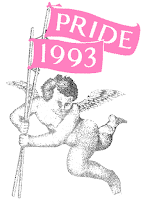On 1stJune I gave the history of the rainbow flag up to the mid-1980s. By 1986 the gay community was fighting global homophobia in the face of the AIDS epidemic. There was a desire to show the world that the community wasn’t about to destroy itself through sex and disease. One group of San Franciscans decided to show the world that gay men are as healthy as any straight man. This group were the organisers of the 1986 Gay Games under the leadership of Tom Waddell.
Waddell’s Olympic career is told here. When the first Gay Games were held in 1982 the AIDS crisis was just building up. By the time of the 2nd Games the organisers decided to use the rainbow flag for the first time as a symbol of pride and celebration. The gay community in San Francisco
The rainbow featured a lot in publicity for the 1986 Gay Games, even featuring on the cover of the official programme. Over 3,000 athletes from all over the world came to compete and many were seeing the rainbow flag for the first time. At many events and all around the streets the Rainbow Pride flag was waved enthusiastically – not in protest, but in celebration. It was a psychological boost that worked, and riding high on the euphoria of a successful high-profile Gay Games the San Franciscans had transformed the Rainbow flag.
But over here in the UK San Francisco
Many people in the UK
In early 1994 the rainbow was seen in large numbers during rallies outside parliament during the campaign for the equalisation of the age of sexual consent. And in the months that followed Pride events around the country made extensive use of the flag at the head of their parades. The first was Brighton Pride in June 1994. London Pride followed a few weeks later.
Meanwhile, back across the Atlantic during the same weekend the rainbow flag reached another (literal) milestone in New York
The record was broken in June 2003 on the 25th anniversary of the Rainbow flag itself. Gilbert Baker was again called upon to recreate his flag – this time in the original 8 stripes. The location for this was Key West , Florida New York
Today the Rainbow Pride flag still hold the record as the most widespread international community flag in history. There is no capital city in the world that has not seen an lgbt citizen waving it or flying it, and also in the Vatican Arctic Circle and as far south as Antarctica . It has influenced hundreds of other flags and thousands of logos. It’s place in history is assured. And even though there have been attempts to introduce new designs it looks like the rainbow will be seen in lgbt skies for a good numbers of years to come.



No comments:
Post a Comment